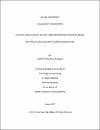Effect of self-healing calcium nitrate microcapsules on concrete properties
Abstract
Self-healing concrete with microencapsulated calcium nitrate was investigated. The compressive strength of concrete admixed with microcapsules (as a percentage of the weight of the cement) was tested and compared with that of control specimens of the same mix design without microcapsules. Surface resistivity tests were conducted to quantify the surface permeability of the concrete specimens with and without microcapsules. The self-healing potential was measured by the modulus of elasticity test (ASTM C469), with measurements being taken before and after damage after 14 days. After the concrete was damaged by application of 80% of its ultimate load, all specimens were incubated by immersion in water. The results showed that the concentration of microcapsules added and the size of the microcapsules had a direct impact on the compressive strength of the concrete. Furthermore, the concrete specimens into which microcapsules were incorporated had greater surface resistivity than the control specimens. The recovery of the modulus of elasticity was analyzed according to the increase from the modulus of elasticity recorded after application of 80% of the sample's ultimate load and the increase relative to the initial modulus of elasticity of the concrete in the virgin state. Overall, the results of this study indicated that although microcapsules caused a decrease in the compressive strength of the concrete, they enhanced the self-healing capability of the concrete that was produced. To take advantage of the benefits of microcapsules, the authors recommend that future work evaluate the use of a dispersing agent to reduce the amount of microcapsules needed in the mix. 2016, National Research Council. All rights reserved.
Collections
- Civil and Environmental Engineering [892 items ]
Related items
Showing items related by title, author, creator and subject.
-
Flexural Behavior of Basalt Fiber Reinforced Concrete Beams with Recycled Concrete Coarse Aggregates
Aljidda, Omar Raad Naji (2017 , Master Thesis)The State of Qatar has experienced tremendous economic development in the last decades. As a result, massive quantities of building materials have been used to accommodate the great pace in construction. However, Qatar ... -
Life cycle cost analysis of structural concrete using seawater, recycled concrete aggregate, and GFRP reinforcement
Younis, A.; Younis, Adel; Ebead, Usama; Judd, Simon ( Elsevier , 2018 , Article)© 2018 Elsevier Ltd Using seawater and recycled concrete aggregate (RCA) in a concrete mix is potentially advantageous from a sustainability perspective. However, the high chloride levels expected in such a case demands ... -
Life cycle cost analysis of sustainable reinforced concrete buildings with treated wastewater, recycled concrete aggregates, and fly ash
Abushanab, Abdelrahman; Alnahhal, Wael ( Elsevier , 2023 , Article)The global excessive demand for concrete has resulted in a significant depletion of concrete natural resources and substantial release of carbon emissions in the environment. To tackle such challenges, treated wastewater ...



